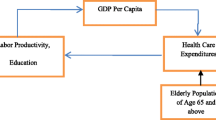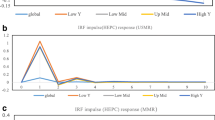Abstract
The objective of this study is to empirically investigate a two-way statistical relationship between the social health indicators and economic growth in the context of four major regions of the world i.e., East Asia and Pacific, Middle East and North Africa (MENA), South Asia and Sub-Saharan Africa. To recognize the relationship between the two variables, a time series, co-integration and Granger causality tests have been employed. Aggregate secondary data pertaining to these four regions from 1975 to 2011 on economic growth and social health indicators i.e., infant mortality, child abuse, child poverty, unemployment, weekly wages, health insurance coverage, teenage suicide, teenage drug abuse, high school dropouts, poverty, out-of-pocket health costs, homicides, alcohol related traffic fatalities, food insecurity, income inequality, HIV/AIDS, tuberculosis, basic health units and rural health centers has been used for analysis. This study evaluates four alternative but equally plausible hypotheses, each with different policy implications. These are: (1) social health indicators Granger cause economic growth, (2) economic growth Granger cause social health indicators (the conventional view), (3) There is a bi-directional causality between the two variables and (4) Both variables are causality independent (although highly correlated). The empirical results only moderately support the conventional view that economic growth has significant long run casual effect on social health indicators in East Asia and Pacific, MENA, South Asia and Sub-Saharan Africa. The present study find evident of unidirectional causality running towards economic growth to social health indicators, although, there are some bidirectional causality also exists between the variables. The percentage of unidirectional causality between economic growth and social health indicators is larger than bidirectional or neutrality hypothesis.

Similar content being viewed by others
References
Altonji, J. G., Cattan, S., & Ware, L. (2013). Identifying sibling influence on teenage substance use. IFS Working Paper W13/04. http://www.ifs.org.uk/wps/wp1304.pdf. Accessed 7 June 2013.
Bask, M., & Salmela-Aro, K. (2013). Burned out to drop out: Exploring the relationship between school burnout and school dropout. European Journal of Psychological Education, 28, 511–528.
Bauer, G., Davies, J. K., & Pelikan, J. (2006). The EUHPID Health Development Model for the classification of public health indicators. Health Promotion International, 21(2), 153–159.
Bhargava, A., Jamison, D. T., Lau, L. J., & Murray, C. J. L. (2001). Modeling the effects of health on economic growth. Journal of Health Economics, 20(3), 423–440.
CIHI. (2013). Health care cost drivers: The facts. The Canadian Institute for Health Information (CIHI). https://secure.cihi.ca/free_products/health_care_cost_drivers_the_facts_en.pdf Accessed 27 July 2013.
Diener, E., Sandvik, E., Seidlitz, L., & Diener, M. (1993). The relationship between income and subjective well-being: Relative or absolute? Social Indicators Research, 28(3), 195–223.
Diener, E., & Suh, E. (1997). Measuring quality of life: Economic, social, and subjective indicators. Social Indicators Research, 40, 189–216.
Easterlin, R. A. (2013). Happiness, growth, and public policy. Economic Inquiry, 51(1), 1–15.
Eastin, J., & Prakash, A. (2013). Economic development and gender equality: Is there a gender Kuznets curve? World Politics, 65(1), 156–186.
Engle, R. F., & Granger, C. W. J. (1987). Cointegration and error correction representation, estimation and testing. Econometrica, 55, 251–276.
FAO. (2012). Economic growth is necessary but not sufficient to accelerate reduction of hunger and malnutrition. Food and Agriculture Organization of the United States. http://www.fao.org/publications/sofi/en/. Accessed 2 March 2013.
Granger, C. W. J. (1981). Some properties of time series data and their use in econometric model specification. Journal of Econometrica, 16, 121–130.
Halleröd, B., Rothstein, B., & Daoud, A. (2013). Bad governance and poor children: A comparative analysis of government efficiency and severe child deprivation in 68 low- and middle-income countries. World Development, 48, 19–31.
Hate, V., & Gannon, S. (2010). Public health in South Asia. A Report of the CSIS Global Health Policy Center, Washington, DC. http://csis.org/files/publication/100715_Hate_PublicHealthSouthAsia_Web.pdf. Accessed 11 September 2012.
Hawe, P., & Shiell, A. (2000). Social capital and health promotion: A review. Social Science and Medicine, 51(6), 871–885.
IFC. (2010). Health & Education in Africa. International Finance Cooperation, Nairobi, Kenya. http://www.ifc.org/wps/wcm/connect/REGION__EXT_Content/Regions/Sub-Saharan+Africa/Investments/HealthEducation/. Accessed 9 July 2012.
IISP. (2013). The Institute for Innovation in Social Policy, Vassar college, Poughkeepsie. http://iisp.vassar.edu/defs_sources.html.
ILO. (2004). The end of child labour: Within reach. Global report under the follow-up to the ILO Declaration on Fundamental Principles and Rights at Work. International labour conference, 95th Session 2006, Report I(B), Geneva.
ILO. (2010). Global Employment Trends for Youth 2010. Special issue on the impact of the global economic crisis on youth. Geneva: ILO.
IMF. (2012). International financial statistics, 2011–12. Washington, DC: International Monetary Fund.
IMF. (2013). Asia and pacific: Shifting risks, new foundations for growth. World economic and financial surveys, regional economic outlook. Washington, DC: International Monetary Fund.
Johansen, S. (1991). Estimation and hypothesis testing of cointegration vectors in gaussian vector autoregressive models. Econometrics, 59, 1551–1580.
Knowles, S. (2001). Inequality and economic growth: The empirical relationship reconsidered in the light of comparable data. Centre for Research in Economic Development and International Trade, University of Nottingham, NO. 01/03. http://www.nottingham.ac.uk/credit/documents/papers/01-03.pdf. Accessed 2 February 2013.
Kuncoro, A. (2000). Microeconomic determinants of economic growth in East Asia. Working paper series 11. http://www2.pids.gov.ph/eadn/EADN%20WP_11.pdf. Accessed 3 March 2013.
Langenbrunner, J. C., & Somanathan, A. (2011). Financing health care in East Asia and the Pacific: Best practices and remaining challenges. World Bank. https://openknowledge.worldbank.org/handle/10986/2321 License: CC BY 3.0 Unported. Accessed 4 June 2013.
Levine, H. M., & Rouse, C. E. (2012). The true cost of high school dropouts. The New York Times. http://www.nytimes.com/2012/01/26/opinion/the-true-cost-of-high-school-dropouts.html?_r=0. Accessed 17 June 2013.
Maclean, J. C., Cantor, J. H., & Pacula, R. L. (2013). Economic downturns and substance abuse treatment: Evidence from admissions data. National Bureau of Economic Research, Working Paper 19115. http://www.nber.org/papers/w19115.pdf?new_window=1. Accessed 5 May 2013.
Miller, A. B., Esposito-Smyther, C., Weismoore, J. T., & Renshaw, K. D. (2013). The relation between child maltreatment and adolescent suicidal behavior: A systematic review and critical examination of the literature. Clinic Child Family Psychological Review, 16, 146–172.
Nobles, J., Weintraub, M. R., & Adler, N. E. (2013). Subjective socioeconomic status and health: Relationships reconsidered. Social Science and Medicine, 82, 58–66.
OECD. (2010). Evidence for action: Gender equality and economic growth. OECD, UK. http://www.oecd.org/dac/gender-development/45568595.pdf. Accessed 17 June 2012.
OECD. (2013). Transforming social institutions to prevent violence against women and girls and improve development outcomes. OECD Development Centre, March 2013. http://www.oecd.org/dev/poverty/OECD_DEV_Policy%20Brief_March%202013.pdf. Accessed 3 May 2013.
OECD/World Health Organization. (2012), Health at a Glance: Asia/Pacific 2012, OECD Publishing. http://dx.doi.org/10.1787/9789264183902-en. Accessed 1 June 2013.
Philips, P. C. B., & Ouliaris, S. (1990). Asymptotic properties of residual based tests for cointegration. Econometrica, 58, 165–193.
Roudi-Fahimi, F., & Moghadam,V. M. (2003). Empowering women, developing society: Female education in the Middle East and North Africa. Population reference bureau, MENA Policy brief, 2003. http://www.prb.org/pdf/EmpoweringWomeninMENA.pdf. Accessed 7 June 2012.
Shih, M., Dumke, K. A., Goran, M. L., & Simon, P. A. (2012). The association between community-level economic hardship and childhood obesity prevalence in Los Angeles. Pediatric Obesity, Early View. doi:10.1111/j.2047-6310.2012.00123.x.
Sohnen, E. (2012). Paying for crime: A review of the relationships between insecurity and development in Mexico and Central America, Woodrow Wilson international center for scholars. Washington, DC: Migration Policy Institute.
Stringham, E. P., & Levendis, J. (2010). Chapter 6: The Relationship between Economic Freedom and Homicide. Economic Freedom of the World: 2010 Annual Report. http://www.fraserinstitute.org/uploadedFiles/fraser-ca/Content/research-news/research/publications/economic-freedom-of-the-world-2010-ch6.pdf. Accessed 17 June 2012.
The Brookings Institution. (2002). The link between growth management and housing affordability: The academic evidence. http://www.brookings.edu/es/urban/publications/growthmang.pdf. Accessed 4 May 2013.
Timmer, C. P. (2004). Food security and economic growth: An Asian perspective. Center for Global Development, Working Papers series 51. http://ideas.repec.org/p/cgd/wpaper/51.html. Accessed 9 May 2013.
UN. (1997). Cost benefit and economic approach related to health care services system. http://www.un.org/womenwatch/daw/csw/cost.htm. Accessed 23 June 2013.
Well, D. N. (2007). Accounting for the effect of health on economic growth. The Quarterly Journal of Economics, 122(3), 1265–1306.
WHO. (2008). Health in Asia and the Pacific. World Health Organization 2008, India. http://www.wpro.who.int/health_information_evidence/documents/Health_in_Asia_Pacific.pdf. Accessed 17 June 2012.
WHO. (2010a). A conceptual framework for action on the social determinants of health. Social determinants of health indicators discussion paper 2. World Health Organization, Geneva.
World Bank. (2010). MENA Health Sector Brief, 2010. World Bank, Washington, DC. http://siteresources.worldbank.org/INTMNAREGTOPHEALTH/Resources/HEALTHBRIEF_SEPT2010.pdf. Accessed 17 July 2013.
World Bank. (2010b). Monetoring social well-being to support policies on the social determinants of health: The case of New Zealand’s “social reports/Te Purongo Oranga Tangata” Social determinants of health indicators discussion paper 3. World Health Organization, Geneva.
World Bank. (2012). World development indicators—2012. Washington DC: World Bank.
Yousef, T. M. (2004). Development, Growth and policy reform in the Middle East and North Africa since 1950. Journal of Economic Perspectives, 18(3), 91–116.
Acknowledgment
This work was financially supported by the National 985 Project of Non-traditional Security at Huazhong University of Science and Technology, P. R. China. Authors are thankful to the anonymous reviewers for their comments and suggestions. Any remaining errors are the authors own responsibility.
Author information
Authors and Affiliations
Corresponding author
Rights and permissions
About this article
Cite this article
Akhmat, G., Zaman, K., Shukui, T. et al. Social Health Indicators and Economic Growth: Evidence from East Asia and Pacific, Middle East and North Africa, South Asia, and Sub-Saharan Africa. Soc Indic Res 119, 663–686 (2014). https://doi.org/10.1007/s11205-013-0538-x
Accepted:
Published:
Issue Date:
DOI: https://doi.org/10.1007/s11205-013-0538-x




